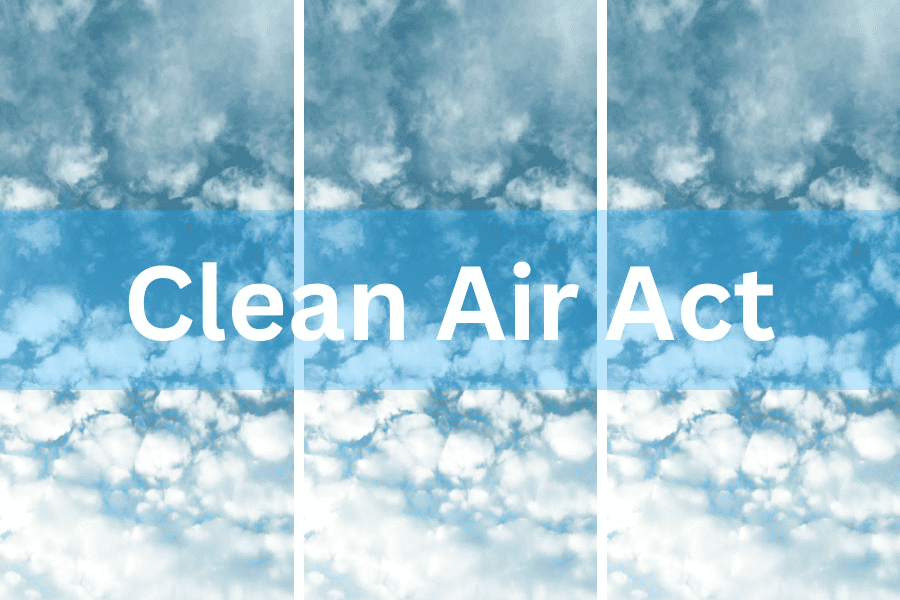Some links on this page are affiliate links. As an Amazon Associate I earn from qualifying purchases which means, if you choose to make a purchase, I may earn a small commission at no extra cost to you. Read Disclosure.
🤍

The Clean Air Act USA: A Comprehensive Guide to Breathing Easy
The Clean Air Act in the United States has played a pivotal role in ensuring the quality of the air we breathe. As a responsible citizen, it’s crucial to understand the significance of this legislation. In this comprehensive guide, we’ll delve into the various aspects of the Clean Air Act USA and its impact on our environment and health. Let’s navigate through the intricacies of this crucial act, keeping our air clean and our communities healthy.
Table of Contents
| Sr | Headings |
|---|---|
| 1 | Understanding the Clean Air Act |
| 2 | Evolution of Clean Air Regulations |
| 3 | Key Components of the Clean Air Act |
| 4 | Impacts on Public Health |
| 5 | Role of EPA in Clean Air Regulation |
| 6 | Successful Implementations and Challenges |
| 7 | Benefits of Clean Air Act Compliance |
| 8 | Current State of Air Quality in the US |
| 9 | Future Perspectives and Amendments |
| 10 | The Global Impact of the Clean Air Act |
1. Understanding the Clean Air Act
The Clean Air Act, established in 1970 and amended in 1990, stands as a comprehensive federal law aimed at regulating air emissions from stationary and mobile sources. This section provides insights into the origins of this critical environmental legislation and its objectives to maintain a healthy atmosphere for all.

2. Evolution of Clean Air Regulations
With the increasing concern over air pollution, the Clean Air Act has undergone several transformative phases. This segment traces the historical development of the act, highlighting significant milestones and revisions that have shaped its current form.
This part of the article explores how the Clean Air Act has evolved and adapted in response to the increasing recognition of the detrimental effects of air pollution on the environment and public health. It emphasizes the various stages of development the Clean Air Act has undergone, highlighting crucial moments and significant alterations that have influenced its present structure and provisions. This section aims to provide readers with a comprehensive understanding of the progression of the Clean Air Act and how it has evolved to address contemporary environmental challenges.
In examining the evolution of the Clean Air Act, some key moments and notable changes have significantly shaped its current structure and regulations. These include crucial milestones such as the initial establishment of the act in 1970 and subsequent amendments made in 1990, which expanded the act’s scope and strengthened its enforcement mechanisms.
Additionally, the introduction of new provisions to address specific pollutants, the implementation of more stringent emission standards for various industries, and the adoption of innovative technologies to monitor and control air quality have all played a pivotal role in shaping the Clean Air Act into its present form. These developments underscore the act’s continuous efforts to adapt to emerging environmental challenges and its commitment to ensuring cleaner and healthier air for all.
The Clean Air Act has undergone several distinct stages of development over the years, each representing a significant phase in its evolution. These stages include the initial formulation of the act in 1970, which marked a pivotal moment in the history of environmental legislation in the United States. Subsequent stages involved crucial amendments and revisions to the original act, aiming to address emerging environmental concerns and incorporate new scientific findings.
These modifications reflect the Act’s responsiveness to evolving challenges, such as the introduction of stricter regulations for specific pollutants, the implementation of more comprehensive monitoring systems, and the integration of innovative technologies to improve air quality management. These stages collectively demonstrate the ongoing commitment of the Clean Air Act to adapting and improving its strategies to combat air pollution and safeguard public health and the environment.
3. Key Components of the Clean Air Act
To comprehend the true essence of the Clean Air Act, it’s imperative to grasp its fundamental components. This part elucidates the core elements and provisions that constitute the backbone of the act, including the National Ambient Air Quality Standards (NAAQS) and emission standards for vehicles and industries.
The Clean Air Act comprises several core elements and provisions that form the fundamental framework of the legislation. These critical components serve as the backbone of the act and include the establishment of National Ambient Air Quality Standards (NAAQS) to regulate the permissible levels of pollutants in the air.
Additionally, the act incorporates stringent emission standards for various sources, such as industrial facilities and vehicles, to control and minimize the release of harmful pollutants into the atmosphere. The Clean Air Act also empowers the Environmental Protection Agency (EPA) to enforce and oversee compliance with the set standards, ensuring the effective implementation of air quality regulations across the nation.
These key elements collectively form the foundation of the Clean Air Act, playing a vital role in preserving and improving air quality while protecting public health and the environment.
The core elements of the Clean Air Act can be specified as follows:
1. National Ambient Air Quality Standards (NAAQS): These are the established standards that define the acceptable levels of pollutants in the air, aiming to protect public health and welfare. NAAQS sets limits on various pollutants, including particulate matter, sulfur dioxide, nitrogen dioxide, carbon monoxide, ozone, and lead.
2. Emission Standards for Various Sources: The Clean Air Act sets specific emission standards for different sources, including industrial facilities, power plants, vehicles, and other sources of air pollution. These standards regulate the amount of pollutants that these sources are permitted to release into the atmosphere, ensuring that emissions remain within acceptable limits.
3. Enforcement by the Environmental Protection Agency (EPA): The EPA is tasked with enforcing and implementing the Clean Air Act regulations. It oversees the monitoring of air quality, conducts inspections, and ensures that industries and other entities comply with the established standards. The EPA’s enforcement activities play a crucial role in maintaining and improving air quality throughout the United States.
These core elements collectively form the backbone of the Clean Air Act, working in conjunction to regulate and reduce air pollution, protect public health, and preserve the environment for current and future generations.
4. Impacts on Public Health
The Clean Air Act’s direct impact on public health cannot be overstated. By curbing harmful pollutants, this legislation has significantly reduced the prevalence of respiratory diseases and other health complications. This section sheds light on how the act has safeguarded the well-being of communities across the nation.
The Clean Air Act has safeguarded the well-being of communities across the nation by implementing stringent regulations that effectively reduce the levels of harmful pollutants in the air. By imposing limits on emissions from various sources such as industrial facilities, power plants, and vehicles, the Clean Air Act has significantly decreased the exposure of individuals to hazardous pollutants known to cause respiratory diseases and other health complications.
This proactive approach has helped in lowering the prevalence of respiratory illnesses and improving overall public health outcomes. Additionally, the Act’s emphasis on the enforcement of National Ambient Air Quality Standards (NAAQS) has played a crucial role in ensuring that the air communities breathe meets specific health-based guidelines, thereby safeguarding the overall well-being and quality of life for people throughout the nation.
5. Role of EPA in Clean Air Regulation
The Environmental Protection Agency (EPA) plays a pivotal role in enforcing and implementing the Clean Air Act. Here, we explore the crucial responsibilities undertaken by the EPA to monitor and regulate air quality, ensuring compliance with the established standards.
The Environmental Protection Agency (EPA) undertakes crucial responsibilities to monitor and regulate air quality, ensuring compliance with the established standards set by the Clean Air Act. These responsibilities include the continuous monitoring of air pollutants through a network of monitoring stations strategically placed across the country.
The EPA conducts regular inspections of industrial facilities, power plants, and other pollution-emitting sources to verify compliance with emission standards and other regulatory requirements. Additionally, the EPA actively engages in the enforcement of the Clean Air Act by issuing permits, conducting investigations, and imposing penalties on entities that violate the established regulations.
Through these rigorous monitoring and regulatory efforts, the EPA plays a pivotal role in safeguarding air quality and protecting public health, thereby upholding the objectives and provisions of the Clean Air Act.
6. Successful Implementations and Challenges
While the Clean Air Act has achieved notable successes, it has also faced its fair share of challenges during implementation. This segment discusses the triumphs and obstacles encountered in the process of executing the act’s regulations and policies.
In the process of executing the Clean Air Act’s regulations and policies, various triumphs and obstacles have been encountered, highlighting the complexities and challenges associated with maintaining air quality standards. Some of the triumphs include significant reductions in key air pollutants, leading to improved public health outcomes and a decrease in the prevalence of respiratory diseases and other related health complications. The implementation of innovative technologies and pollution control measures has also contributed to notable improvements in air quality across the nation.
However, the execution of the Clean Air Act has also faced several obstacles, such as resistance from certain industries and stakeholders, who have expressed concerns about the economic impact of complying with the stringent regulations. The Act’s implementation has at times been hindered by conflicting interests and varying interpretations of environmental policies, leading to delays in enforcement and regulatory processes.
Additionally, the evolving nature of air pollution and the emergence of new pollutants have posed challenges in consistently updating and adapting the Act to effectively address these changing environmental concerns. Overcoming these obstacles has required concerted efforts from regulatory agencies, industry stakeholders, and advocacy groups to find common ground and develop effective strategies for continued progress in air quality management and environmental protection.
7. Benefits of Clean Air Act Compliance
Compliance with the Clean Air Act not only ensures a healthier environment but also brings forth a myriad of other benefits. This part delineates the economic, societal, and environmental advantages associated with adhering to the regulations set forth by this crucial legislation.
Adhering to the regulations set forth by the Clean Air Act offers numerous economic, societal, and environmental advantages. Economically, compliance with the Act promotes the growth of innovative technologies and industries focused on developing cleaner energy sources and pollution control technologies. This fosters job creation and stimulates economic development in the clean energy sector, contributing to sustainable economic growth and stability.
From a societal perspective, adhering to the Clean Air Act’s regulations leads to improved public health outcomes, resulting in reduced healthcare costs and an overall enhancement in the quality of life for communities. By reducing the prevalence of respiratory diseases and other health complications, the Act helps create healthier and more productive communities, fostering a better standard of living and well-being for individuals.
Environmentally, adherence to the Clean Air Act contributes to the preservation of ecosystems and natural resources by mitigating the adverse impacts of air pollution on biodiversity and ecological balance. It helps protect vulnerable ecosystems, reduces the harmful effects of acid rain, and minimizes the degradation of natural habitats, promoting the conservation and sustainability of environmental resources for future generations. These combined benefits underscore the importance of adhering to the regulations established by the Clean Air Act and the positive impacts it has on the economy, society, and the natural environment.
8. Current State of Air Quality in the US
Assessing the present air quality scenario in the United States is integral to understanding the effectiveness of the Clean Air Act. This section provides a comprehensive analysis of the current air quality status, emphasizing the areas of improvement and the persistent challenges that demand attention.
In studying the Clean Air Act, a comprehensive analysis of the current air quality status reveals both areas of improvement and persistent challenges that require attention. Despite significant advancements in air quality management, certain regions still experience elevated levels of air pollution, particularly in densely populated urban areas and industrial zones. The implementation of the Clean Air Act has resulted in noticeable improvements in air quality indicators, with reductions in key pollutants such as particulate matter, sulfur dioxide, and nitrogen oxides.
However, challenges persist, primarily in areas where industrial activities and vehicular emissions remain major contributors to air pollution. These regions continue to face difficulties in achieving and maintaining compliance with the established air quality standards, necessitating the implementation of more stringent regulations and the adoption of advanced pollution control technologies. Additionally, the impact of natural phenomena such as wildfires and dust storms poses a recurring challenge to maintaining optimal air quality levels in certain geographical areas.
Efforts to address these challenges include the development of comprehensive air quality monitoring systems, the promotion of cleaner energy alternatives, and the continued implementation of emission reduction strategies for both stationary and mobile sources. Collaborative initiatives between governmental agencies, private industries, and local communities are crucial in mitigating the persistent challenges and ensuring sustained progress in improving air quality nationwide.
9. Future Perspectives and Amendments
As our society continues to evolve, the Clean Air Act must adapt to address emerging environmental concerns. Here, we discuss potential future amendments and perspectives that could further strengthen the act’s efficacy in preserving the nation’s air quality and mitigating the risks associated with air pollution.
Several potential future amendments and perspectives could further enhance the efficacy of the Clean Air Act in preserving the nation’s air quality and mitigating the risks associated with air pollution. These include the integration of more stringent regulations for emerging pollutants not currently covered by the Act, such as volatile organic compounds (VOCs) and specific greenhouse gases. Additionally, the implementation of comprehensive strategies to promote the adoption of renewable energy sources and incentivize the transition to cleaner energy technologies could significantly contribute to reducing overall emissions and improving air quality.
Furthermore, the promotion of sustainable transportation solutions, including the expansion of public transit networks and the development of infrastructure for electric vehicles, would help minimize vehicular emissions and alleviate air quality concerns in urban areas.
Emphasizing community engagement and public awareness campaigns to encourage active participation in air quality preservation efforts is also essential for fostering a collective sense of responsibility and ensuring the long-term success of air quality initiatives.
Moreover, considering the potential impacts of climate change on air quality, integrating climate resilience strategies into the Clean Air Act’s framework would strengthen the nation’s ability to adapt to changing environmental conditions and mitigate the adverse effects of air pollution on public health and the environment.
These proactive measures, when implemented collectively, can fortify the Clean Air Act’s role in safeguarding the nation’s air quality and promoting sustainable environmental practices for future generations.

10. The Global Impact of the Clean Air Act
The impact of the Clean Air Act extends beyond the borders of the United States. This segment highlights the global implications of the act, emphasizing its role as a guiding beacon for international environmental policies and initiatives.
The Clean Air Act holds significant global implications, serving as a guiding beacon for international environmental policies and initiatives. Its robust framework and effective implementation have positioned it as a model for other nations seeking to enhance their air quality management strategies and mitigate the adverse impacts of air pollution.
By showcasing successful methodologies for controlling emissions and promoting sustainable practices, the Clean Air Act has inspired the development of similar legislative frameworks and regulatory frameworks in various countries worldwide.
Furthermore, the Act’s emphasis on fostering collaborative partnerships and knowledge-sharing initiatives has facilitated international cooperation in addressing transboundary air pollution issues and promoting global environmental sustainability. Its influence has extended beyond national borders, encouraging the adoption of harmonized air quality standards and the establishment of multinational agreements aimed at reducing cross-border pollution and promoting regional air quality improvement efforts.
Moreover, the Clean Air Act’s proactive approach to addressing emerging environmental challenges has contributed to shaping international environmental discourse and fostering global awareness of the importance of air quality preservation.
By highlighting the interconnected nature of air pollution and its impact on global health and the environment, the Clean Air Act has catalyzed discussions on the need for concerted global action to combat air pollution and promote sustainable development practices worldwide.
Conclusion
In conclusion, the Clean Air Act USA remains a cornerstone of environmental protection, fostering a healthier and more sustainable future for generations to come. By fostering awareness and encouraging active participation, we can collectively contribute to the preservation of our planet’s most vital resource—clean air.
Frequently Asked Questions (FAQs)
- What is the primary purpose of the Clean Air Act? The primary purpose of the Clean Air Act is to regulate air emissions and ensure clean and breathable air for all citizens.
- How does the Clean Air Act impact the economy? The Clean Air Act’s positive impact on public health and the environment ultimately benefits the economy by reducing healthcare costs and fostering sustainable development.
- What are some common air pollutants regulated under the Clean Air Act? Some common air pollutants regulated under the Clean Air Act include particulate matter, sulfur dioxide, carbon monoxide, lead, and nitrogen oxides.
- How does the Clean Air Act address climate change? While primarily focused on air quality, the Clean Air Act indirectly contributes to mitigating climate change by reducing greenhouse gas emissions and promoting cleaner energy alternatives.
- How can individuals contribute to supporting the Clean Air Act’s objectives? Individuals can contribute to supporting the Clean Air Act’s objectives by practicing energy conservation, using eco-friendly transportation, and advocating for sustainable environmental policies at local and national levels.
This comprehensive guide provides a holistic understanding of the Clean Air Act USA, shedding light on its historical significance, present impact, and future implications. Let’s strive together to uphold the standards set by this vital legislation and pave the way for a cleaner and healthier tomorrow.
Amazon and the Amazon logo are trademarks of Amazon.com, Inc, or its affiliates.







Leave a Reply